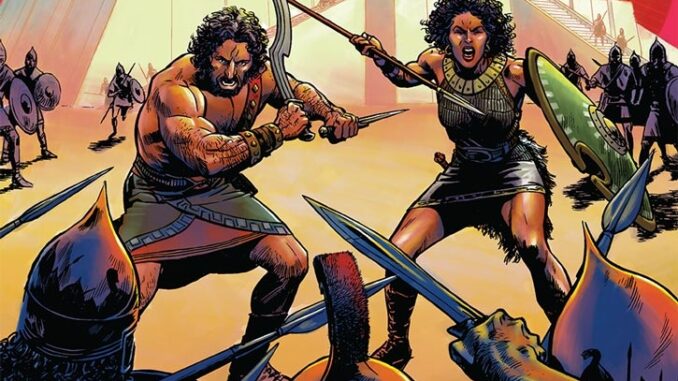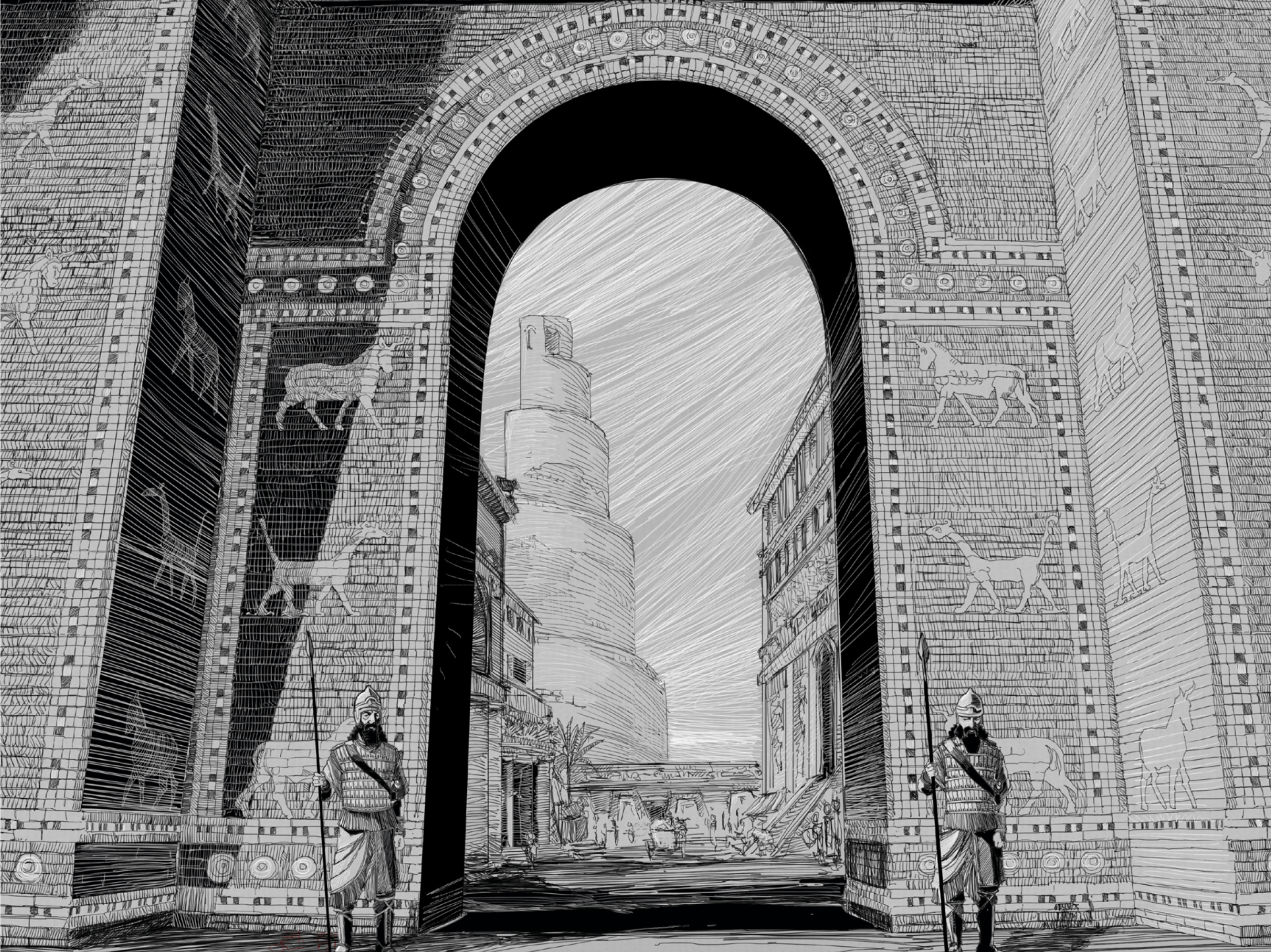
Taken from Cover Art by Adam Moore
I have a confession to make – when it comes to the Fantasy genre, I’ve always preferred Sword & Sorcery and Low Fantasy settings like Hyperborea (Conan) or Westeros (A Song of Ice and Fire) to epic, high fantasy settings like Tolkien’s Middle Earth (don’t get me wrong, Middle Earth and all of its related works and lore are fantastic – I’m just talking about in general). I’m much more into the political struggles, interpersonal dramas, and adventures into unknown and dangerous lands; magic should be something rare, powerful, and mysterious – not a basic resource everyone can use. Of course, many don’t share my preferences, but that’s okay.
I also happen to be a lover of both ancient history and mythology. I became fascinated with the Greek pantheon and myths at a young age, and that interested expanded to learning about mythologies from all over the world; perhaps unsurprisingly, my love of mythology lead me to learn more about the societies and cultures that spawned those myths. That, more than anything, is probably why I always loved History class, and why I continue to consume books, podcasts, and games about history to this day. Imagine my delight, then, when I discovered that there was a game was not only solidly grounded in the Sword & Sorcery genre, but also took Mythic Mesopotamia as its setting. That RPG is Blood & Bronze, a Bronze-Age Sword & Sorcery RPG. The book is rules-light, covering everything you need to know to run and play the game in 68 pages.
The Setting
As mentioned, Blood & Bronze (B&B) takes place in Ancient Mesopotamia, the birthplace of the Sumerian civilization, centered in modern-day Iraq. Rather than taking a rigid, historical approach, rich, mythic elements pervade the setting – Mesopotamian gods like Shamash are real, as are the monstrous, legendary creatures that roam the land. The setting chapter starts off with a broad-strokes description of the settings, including the geography and cultures, then drills down to tackle some of these aspects in more depth.
The focal point of the setting is Sippar, a multicultural hub of trade and commerce. Other settlements are few and far between, and reaching them requires travelers to traverse dangerous, uncharted wilderness; outside the safety of civilization, you might run into wild animals, roving bandits, or even legendary monsters. Ancient ruins from before the Great Flood can be explored, their treasures recovered. You might even find powerful artifacts that bestow upon you powers from the gods. This setup lends itself perfectly to a hexcrawl campaign, and that indeed seems to be the intention of the creators; the game also has lots of random tables and rules for making your way across the map and for various points of interest.
There are multiple historical cultures described in the game. The Sumerians are there, of course, but so are many other contemporary cultures like the Akkadians, Kuthians, and Amorites, among others. Even if you’re not a history buff, you may recognize some of these peoples from various history classes or possibly from some of the holy books originating from the Middle East. The cultures are there for populating the settings and creating PCs, but they exist solely for flavor and physical descriptions. We get plenty of other cultural information sprinkled throughout the rest of the book, including brief descriptions of currency, clothing, and various goods that can be bought and sold across Mesopotamia.

A map of Mythic Mesopotamia.
Art by Sam Perkins-Harbin
Core Mechanics
Blood & Bronze was designed to be rules-light, and that’s definitely the case when it comes to core mechanics. Whenever there’s a question of whether or not a PC fails or succeeds at a dramatic action, you roll a skill test. Some example skills in B&B include Manipulate, Treat Wounds, and Use Force. Each skill is associated with one of six Abilities: Guile, Lore, Senses, Craft, Vigor, and Might. Ability Scores are determined during character creation by the standard 3d6 roll, resulting in a value between 3 and 18. The Ability Scores are then converted into Ability Ratings, which range from 1 to 6. The Ability Rating tells you how many dice you roll for a Skill Test associated with that attribute. If at least one die comes up as a 5 or 6, you’ve succeeded.
You may be wondering why the game would bother to have you roll 3d6, only to convert it to a number from 1 to 6. The reason for this is Saving Throws. Saving Throws are the second major roll type in the game. One rolls a Saving Throw when the PC is reacting to a threat using reflexes and/or instincts. In these cases, you roll 1d20 and compare it to the relevant Attribute Score (3-18). If the roll is less than or equal to the Attribute Score in question, the PC succeeds at the Saving Throw; that is, unless you roll a 1 or a 20, which are always a success and failure, respectively.
That’s it. Those two basic mechanics cover almost every roll in B&B.

Interior Art by Rich Longmore
Character Creation
The character creation process in Blood & Bronze is simple and straightforward. After rolling your Ability Scores and determine your Ability Ratings (as explained in the section above), you can choose or roll for a Background, then choose a Class and record your Starting Equipment. Pretty easy-peezy.
Backgrounds describe what the PC did before becoming an adventurer. All the options seem quite appropriate for Ancient Mesopotamia, with choices like Brewer, Bricklayer, Herder, and Basket maker. None of these background have any impact on your character beyond fluff and roleplaying fodder, and Backgrounds are completely optional. Considering how integral the setting is to the game, though, I definitely recommend putting in the time and coming up with an interesting backstory for your character.
Character Classes in B&B are at once familiar and delightfully unique. For example, The Mercenary and The Rogue generally correspond to the traditional Fighter and Thief options in many RPGs. However, The Mercenary is not only skilled in multiple weapons, but can also recieve specializations (something similar to Feats or Talents in other games) in negotiating and field medicine. The Rogue, while an able thief, can also perform mimicry, craft poisons, and can adjust certain rolls in situations related to their Background, if they chose one. The Mystic, a sort of stand-in for a Cleric, uses narcotics to perform divine magic, but must continually get their fix or suffer the torments of withdrawal; The Desert Farer, which is similar to a Ranger, is skilled at navigating dangerous terrain and surviving under harsh conditions, but can also stealth by blending in with the desert mirages and learn foreign languages remarkably quickly; the closest comparison to The Courtesan is the Bard, but they can also enter people’s dreams and learn their secrets, as well as lip-read; finally, The Seer is the Mesopotamian version of a Wizard, but with the ability to cast bone magic (using bone salt mixed with blood) to perform more necromantic/eldritch spells like seeing through the eyes of the dead or cursing enemies with the Evil Eye of misfortune.

Interior Art by Rich Longmore
The Skinny
Blood & Bronze is a fantastic game if you like the Sword & Sorcery genre, mythology, ancient history, or any combination thereof. It seems great for hex-crawling across the Fertile Crescent. There’s a lot of flavor and fun in this small package, and its design ensures that you and the other players can get playing quickly without getting bogged down by rules. The brevity of the product, however, is probably also its greatest detriment. While I thought the creators did an excellent job with concise explanations of the settings, rules, and GM advice, the lack of depth left me wanting more of everything. And that’s really what it boils down to: if you and your group are the sorts of gamers who don’t mind taking ownership of the game and filling in blanks to taste, then this should be a very enjoyable game for you; if you and your group are the sorts of gamers who like to have more guidance and inspiration, you may find the game a bit disappointing.
Do you have thoughts or questions about the article or suggestions for future content? Leave a comment below or drop me a line at jtdimino@d20radio.com
J.T. Dimino
Latest posts by J.T. Dimino (see all)
- The PC Factory: Aedan the Druid (Old School Essentials) - January 26, 2021
